ARCHIVED - Energy Use in Canada's North: An Overview of Yukon, Northwest Territories, and Nunavut - Energy Facts
This page has been archived on the Web
Information identified as archived is provided for reference, research or recordkeeping purposes. It is not subject to the Government of Canada Web Standards and has not been altered or updated since it was archived. Please contact us to request a format other than those available.
ISSN 1925-2706

March 2011
Fossil Fuel Consumption
Energy use in the Canadian North is notably different from the rest of the country. Almost three-quarters of northern fuel consumption is a by-product of refined oil (Figure 1). As very little oil is usable in its raw extracted form, almost all fuel is imported from provinces in the south. A large percentage of the imported fuel is fuel oil or propane for heating, and diesel fuel for transportation and electricity generation. Natural gas, the major fuel in Canada if transportation is excluded, accounts for only 12 per cent of energy use in the North. There is a small amount of local natural gas used in Inuvik and Norma Wells.
Figure 1: Fuel Type Usage - Canada vs. North
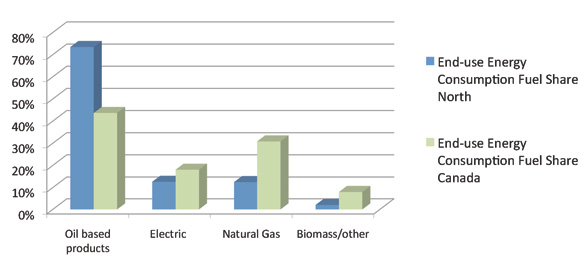
Source: NEB, 2009
Northern Energy Facts
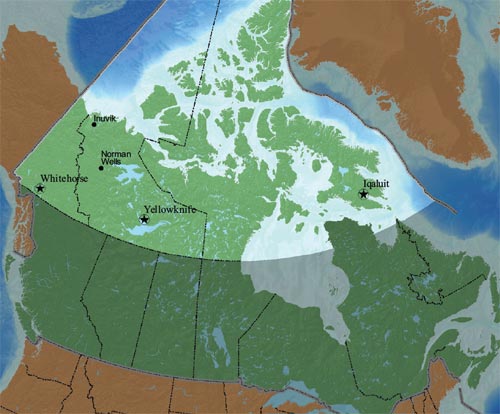
- The North accounts for only about 0.3 per cent of Canada's population and energy use.
- With a population of just over 100,000 dispersed over 3.5 million square kilometres, the costs and logistics of energy distribution is a major issue.
- Energy costs are a major contributor to the high cost of living in the North. Per capita energy use is almost twice the Canadian average.
- Natural Resources Canada estimates that there are over 300 isolated communities in Canada that rely on diesel generators for electricity; almost half of these are in the territories or along the northern-most regions of the provinces.
- Overall, hydro is the largest source of electricity generation for the North; however, distribution is very limited. Nunavut is 100 per cent diesel generated electricity.

Energy Supply and Demand
 Both renewable and non-renewable resources show enormous potential in the North. Only a fraction of these resources have been developed. In contrast to the diversity and size of the energy supply options in the North, local consumers of energy have more limitations than almost anywhere in Canada. The influence of climate, geography, and dispersed population contribute to a unique pattern of energy use.
Both renewable and non-renewable resources show enormous potential in the North. Only a fraction of these resources have been developed. In contrast to the diversity and size of the energy supply options in the North, local consumers of energy have more limitations than almost anywhere in Canada. The influence of climate, geography, and dispersed population contribute to a unique pattern of energy use.
Some unique characteristics include a low share of industrial fuel use, and a very high share of government/institution use in the commercial sector. Industrial demand is noticeably influenced by the opening and closing of large, scattered industrial operations in the North.
Transportation fuel use is also unique, and very site-specific. The Yukon has over 4,000 kilometres of highways; Nunavut has no permanent highways, and yet transportation fuel accounts for approximately half of petroleum volume sales. This is split between on-road, off-road, and aviation fuel. Many communities in the North are accessible only by small planes. A large volume of freight is moved by marine vessels during the short open water season.
Electricity and home heating costs are significantly higher in the North compared to southern Canada (Figure 2). Electricity costs in some communities have been over 10 times higher than the Canadian average on a per kilowatt-hour basis. The government of Northwest Territories has announced a leveling of electrical energy costs throughout most of the territory that started in October 2010[1]. Even with the high retail rates, energy costs in the area are subsidized by territory governments.
[1] Northwest Territories Power Corporation, Leaders Letter, Issue 2, 2010
Figure 2: Annual Heating Cost Comparison by Fuel, 2007[2]

[2] Government of Northwest Territories. Industry, Tourism and Investment, Energy for the Future: An Energy Plan for the Northwest Territories, 2007.
Although wood stoves are common for space heating in northern households, most homes still have a secondary heating device using oil, gas, or electricity.
Territorial Energy Maps - Canada's North
Location of Renewable and Non-renewable Resources and Infrastructure
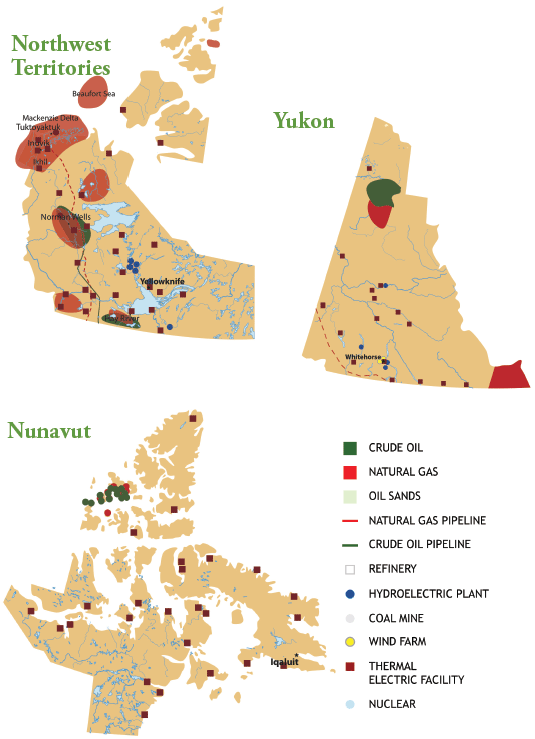
Source: Centre for Energy. For further information please visit www.centreforenergy.com.
Energy Options for the North
The following table provides a summary of efficiency, conservation, and renewable energy options in use and/or under review at present in the north.
Energy Conservation and Energy Efficiency
 All three territories have identified energy efficiency and energy conservation as a top priority.[3,4,5] Programs include rebates for approved heating equipment and home appliances, subsidized energy audits, and energy information programs. Yukon has a goal of 20 per cent improvement in efficiency by 2020.
All three territories have identified energy efficiency and energy conservation as a top priority.[3,4,5] Programs include rebates for approved heating equipment and home appliances, subsidized energy audits, and energy information programs. Yukon has a goal of 20 per cent improvement in efficiency by 2020.
[3] Government of Northwest Territories. Industry, Tourism and Investment, Energy for the Future: An Energy Plan for the Northwest Territories, 2007
[4] Government of Yukon, Energy, Mines and Resources, Energy Strategy for Yukon, 2009.
[5] Government of Nunavut, Ikummatiit: The Government of Nunavut Energy Strategy, 2007
Hydro
 The Yukon has three 3 established hydro plants with the ability to generate 75 megawatts. The Northwest Territories hydro strategy shows over 11,000 megawatts of hydro potential for the region, however, less than 0.5 per cent of this has been developed.
Nunavut has high hydro potential; however, development has not been economically
feasible. All regions are also closely evaluating mini-hydro (run-of-river) potential.
The Yukon has three 3 established hydro plants with the ability to generate 75 megawatts. The Northwest Territories hydro strategy shows over 11,000 megawatts of hydro potential for the region, however, less than 0.5 per cent of this has been developed.
Nunavut has high hydro potential; however, development has not been economically
feasible. All regions are also closely evaluating mini-hydro (run-of-river) potential.
Wind
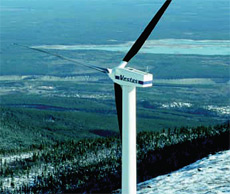 Wind projects have been demonstrated in
all three territories, with very mixed results. Yukon has had at least one turbine operating
over the last 15 years at Haeckel Hill, near Whitehorse. Consultants have identified
over 60 possible sites in the territories for wind projects[6]. At least eight communities
are presently monitoring wind resources for possible future installations. However,
long term reliability, grid integration ability, and economic feasibility have not been
established. With improving technology and decreasing costs, installations should increase. Alaska has been moderately successful with several community wind projects. These are being reviewed as a model
for other communities.
Wind projects have been demonstrated in
all three territories, with very mixed results. Yukon has had at least one turbine operating
over the last 15 years at Haeckel Hill, near Whitehorse. Consultants have identified
over 60 possible sites in the territories for wind projects[6]. At least eight communities
are presently monitoring wind resources for possible future installations. However,
long term reliability, grid integration ability, and economic feasibility have not been
established. With improving technology and decreasing costs, installations should increase. Alaska has been moderately successful with several community wind projects. These are being reviewed as a model
for other communities.
[6] Remote Community Wind Energy Conference, Sponsored by Government of Northwest Territories, 2008.
Biomass
 Wood is already widely used for space
heating; however, wood pellets and high efficiency pellet stoves/boilers are being
used in residential applications and have been demonstrated in a few commercial
applications. An Arctic Energy Alliance report noted promising potential for biomass in the
North.[7] Further economic and environmental benefits could be achieved if a northern pellet supply industry develops. A few demonstration projects have been successful and there is great interest in pursuing more projects in the Territories.
Wood is already widely used for space
heating; however, wood pellets and high efficiency pellet stoves/boilers are being
used in residential applications and have been demonstrated in a few commercial
applications. An Arctic Energy Alliance report noted promising potential for biomass in the
North.[7] Further economic and environmental benefits could be achieved if a northern pellet supply industry develops. A few demonstration projects have been successful and there is great interest in pursuing more projects in the Territories.
[7] Government of Northwest Territories, Environment and Natural Resources. NWT Biomass Energy Strategy, 2010 and Arctic Energy Alliance
Geothermal
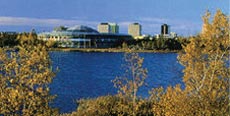 The Canadian Geothermal Energy Association
identified a potential 5000 megawatts of energy capacity in developing the best sites
in British Columbia, Yukon, and the Northwest Territories. Two small demonstration projects
(near Fort Liard and Yellowknife) have been announced. The near term objective is
capturing heat (thermal) energy, although combined electricity generation and thermal
energy is the long-term goal.
The Canadian Geothermal Energy Association
identified a potential 5000 megawatts of energy capacity in developing the best sites
in British Columbia, Yukon, and the Northwest Territories. Two small demonstration projects
(near Fort Liard and Yellowknife) have been announced. The near term objective is
capturing heat (thermal) energy, although combined electricity generation and thermal
energy is the long-term goal.
Diesel Generator Improvements
 There is a continuing trend of improving efficiency on generators. This includes waste heat recovery and implementing automation and controls for matching output and loads. The technology is well understood, and, although not a totally satisfactory solution, is generally seen as a reliable and least-cost, near-term solution.
There is a continuing trend of improving efficiency on generators. This includes waste heat recovery and implementing automation and controls for matching output and loads. The technology is well understood, and, although not a totally satisfactory solution, is generally seen as a reliable and least-cost, near-term solution.
Solar, fuel cells, storage and hybrids
 There is great interest in the development
of several alternative energy technologies. Many of these technologies would be ideally suited to remote locations. Fuel cells, solar thermal, heat pumps, district heating, and solar photovoltaic have each
been demonstrated in the North. While not presently economically attractive, decreasing costs and improving technology, especially in niche applications, has kept interest high.
There is great interest in the development
of several alternative energy technologies. Many of these technologies would be ideally suited to remote locations. Fuel cells, solar thermal, heat pumps, district heating, and solar photovoltaic have each
been demonstrated in the North. While not presently economically attractive, decreasing costs and improving technology, especially in niche applications, has kept interest high.
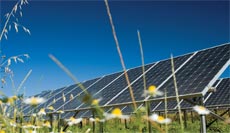 One of the most promising opportunities
to apply new technology is through a combination of new technologies. As an example, a fuel cell that uses surplus hydro power for storing energy could be used to meet peak loads in electricity. Wind-diesel
and wind-diesel-storage systems are also showing promise as they take advantage of complementary strengths and improve overall reliability. Several of the successful applicants for the 2010 Federal government
Clean Energy Funds Program support these strategies.[8]
One of the most promising opportunities
to apply new technology is through a combination of new technologies. As an example, a fuel cell that uses surplus hydro power for storing energy could be used to meet peak loads in electricity. Wind-diesel
and wind-diesel-storage systems are also showing promise as they take advantage of complementary strengths and improve overall reliability. Several of the successful applicants for the 2010 Federal government
Clean Energy Funds Program support these strategies.[8]
[8] Natural Resources Canada, Science and Technology, Clean Energy Fund Program
Summary
With the small population and high costs of developing alternative energy options, the opportunities for implementing new technology are limited. However, small projects, evaluated on a site-by-site basis, are continuing to be implemented and assessed. The high cost of existing energy supply could support a practical proving ground for implementing emerging technology in Canada.
The conclusion from Ikummatiit, the Government of Nunavut Energy Strategy, provides a summary that could apply to the North as a whole:
"While opportunities for making real and positive changes in the energy sector are great, some difficult decisions lie ahead. Real solutions will require positive changes in consumer behaviour, government operations and cooperation among governments, departments and agencies. Education about true energy costs and the environmental consequences of energy choices is critical. Displacement of some the fossil fuels Nunavummiut use by other sources will result in favourable environmental impacts and also should result in a portion of the economic benefit of energy being retained in Nunavut, even if the overall cost of energy is not significantly decreased. Currently, energy represents a financial and environmental burden, but by taking a clear and careful look at our energy options, Nunavummiut can develop energy as a tool and resource for Nunavut's future."
- Date modified:
